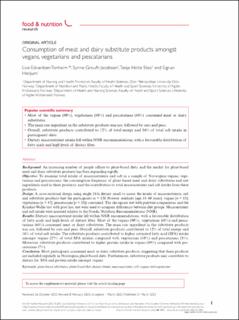| dc.contributor.author | Edvardsen Tonheim, Live | |
| dc.contributor.author | Groufh-Jacobsen, Synne | |
| dc.contributor.author | Stea, Tonje Holte | |
| dc.contributor.author | Henjum, Sigrun | |
| dc.date.accessioned | 2023-05-16T10:47:56Z | |
| dc.date.available | 2023-05-16T10:47:56Z | |
| dc.date.created | 2023-04-01T09:41:15Z | |
| dc.date.issued | 2023 | |
| dc.identifier.citation | Edvardsen Tonheim, L., Groufh-Jacobsen, S., Stea, T. H. & Henjum, S. (2023). Consumption of meat and dairy substitute products amongst vegans, vegetarians and pescatarians. Food & Nutrition Research (FNR), 67, 1-11. doi: | en_US |
| dc.identifier.issn | 1654-6628 | |
| dc.identifier.uri | https://hdl.handle.net/11250/3068178 | |
| dc.description.abstract | Background: An increasing number of people adhere to plant-based diets, and the market for plant-based meat and dairy substitute products has been expanding rapidly.Objective: To examine total intake of macronutrients and salt in a sample of Norwegian vegans, vege-tarians and pescatarians; the consumption frequency of plant-based meat and dairy substitutes and raw ingredients used in these products; and the contribution to total macronutrient and salt intake from these products.Design: A cross-sectional design using single 24-h dietary recall to assess the intake of macronutrients, salt and substitute products that the participants (n = 158 Norway residents [age 18–60 years]: vegans [n = 83]; vegetarians [n = 47]; pescatarians [n = 28]) consumed. The chi-square test with pairwise comparisons and the Kruskal-Wallis test with post hoc test were used to compare differences between diet groups. Macronutrient and salt intake were assessed relative to the Nordic Nutrition Recommendations (NNR).Results: Dietary macronutrient intake fell within NNR recommendations, with a favourable distribution of fatty acids and high levels of dietary fibre. Most of the vegans (90%), vegetarians (68%) and pesca-tarians (64%) consumed meat or dairy substitutes. The main raw ingredient in the substitute products was soy, followed by oats and peas. Overall, substitute products contributed to 12% of total energy and 16% of total salt intake. The substitute products contributed to higher saturated fatty acid (SFA) intake amongst vegans (27% of total SFA intake) compared with vegetarians (10%) and pescatarians (8%). Moreover, substitute products contributed to higher protein intake in vegans (19%) compared with pes-catarians (7%).Conclusion: Most participants consumed meat or dairy substitute products, suggesting that these products are included regularly in Norwegian plant-based diets. Furthermore, substitute products may contribute to dietary fat, SFA and protein intake amongst vegans. | en_US |
| dc.language.iso | eng | en_US |
| dc.publisher | Swedish Nutrition Foundation | en_US |
| dc.rights | Navngivelse 4.0 Internasjonal | * |
| dc.rights.uri | http://creativecommons.org/licenses/by/4.0/deed.no | * |
| dc.title | Consumption of meat and dairy substitute products amongst vegans, vegetarians and pescatarians | en_US |
| dc.type | Peer reviewed | en_US |
| dc.type | Journal article | en_US |
| dc.description.version | publishedVersion | en_US |
| dc.rights.holder | © 2023 The Author(s) | en_US |
| dc.subject.nsi | VDP::Medisinske Fag: 700::Helsefag: 800::Ernæring: 811 | en_US |
| dc.source.pagenumber | 11 | en_US |
| dc.source.volume | 67 | en_US |
| dc.source.journal | Food & Nutrition Research (FNR) | en_US |
| dc.identifier.doi | 10.29219/fnr.v67.9081 | |
| dc.identifier.cristin | 2139026 | |
| dc.relation.project | OsloMet - storbyuniversitetet: 689019 | en_US |
| dc.source.articlenumber | 9081 | en_US |
| cristin.qualitycode | 1 | |

